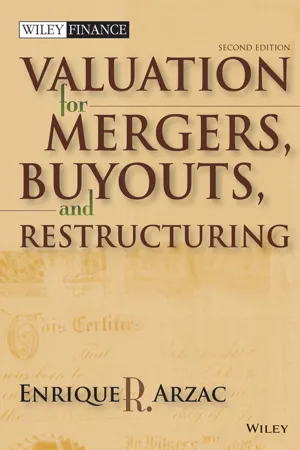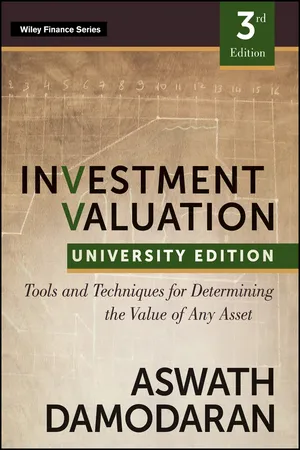Business
Adjusted Present Value
Adjusted Present Value (APV) is a financial valuation method used to evaluate the impact of financial leverage on a company's value. It involves adjusting the present value of a project's cash flows by considering the effects of debt financing. By incorporating the tax shield benefits and costs of financial distress, APV provides a more comprehensive assessment of investment opportunities.
Written by Perlego with AI-assistance
Related key terms
1 of 5
5 Key excerpts on "Adjusted Present Value"
- eBook - PDF
Valuation
Mergers, Buyouts and Restructuring
- Enrique R. Arzac(Author)
- 2015(Publication Date)
- Wiley(Publisher)
We call this method recursive WACC . Fortunately, discounting in this case can be reduced to discounting each year’s sum of free cash flow and tax shield at the cost of capital of the unlevered firm. This alternative procedure is called compressed Adjusted Present Value . (3) Furthermore, in high-leverage situations such as LBOs, debt reduction is a function of uncertain cash-flow realizations and results in a debt ratio that is itself uncer- tain, further complicating the valuation problem. 1 Handling this case requires a variation of APV called recursive Adjusted Present Value . These variations may seem unnecessarily confusing at this point, and the reader may hesitate before undertaking the rather tedious task of going through the mechanics of each. However, such an undertaking would provide the tools for dealing with the most common departures from standard WACC valuation. 6.2 Adjusted Present Value AND THE VALUE OF THE TAX SHIELD Myers’s APV rule 2 provides a straightforward procedure for valuing a firm with prede- termined changes in the level of debt. It does so by partitioning cash flows into more easily valued components such that the value of the leveraged firm is made up of the value of the firm without debt plus the value of its tax shield. This result is quite general. We shall show it allowing for personal taxes. At the cost of burdening the argument with additional notation we provide an explicit examination of the role of personal taxes in APV valuation. - Josh Lerner, Ann Leamon, Felda Hardymon(Authors)
- 2012(Publication Date)
- Wiley(Publisher)
The company’s phone is 800-289-2550 or 303-534-1515; its fax, 303-534-4818; and its URL http://www.decisioneering.com. 100 Chapter 4 Assigning Value THE Adjusted Present Value METHOD The APV method is a variation of the NPV method. APV is preferred over the NPV method where a firm’s capital structure is changing or has NOLs that can be used to offset taxable income. (An example demonstrating the APV method can be found in Example 4.3.) FIGURE 4.1 Simulation report produced by Crystal Ball using data from NPV example The Adjusted Present Value Method 101 EXAMPLE 4.3 Sample Valuation Using the Adjusted Present Value Method Vulture Partners, a private equity organization specializing in distressed company investing, was interested in purchasing Turnaround. Mr. Fang, a general partner at Vulture, used the projections in Table 4.7 to value Turnaround (all data are in millions of dollars): Turnaround had $220 million of NOLs available to offset future income. At the beginning of Year 1, the company had $75 million of 8 percent debt, which was expected to be repaid in three $25 million installments beginning at the end of Year 1. The tax rate was 40 percent. Mr. Fang believed an appropriate unlevered beta for Turnaround was 0.8. The ten-year Treasury bond yield was 7.0 percent and the market risk premium 7.5 percent. Net cash flows were forecast to grow at 3 percent per year in perpetuity after Year 5. Mr. Fang performed the following steps. As shown in Table 4.8, Mr. Fang employed the APV method to value Turnaround and, as such, used the cost of equity as the discount rate: Cost of Equity ¼ r f þ b u ðr m r f Þ ¼ 7:0 þ 0:8 ð7:5Þ ¼ 13% Cash flows and the terminal value were both calculated in the same manner as under the NPV method. Mr. Fang arrived at a terminal value of $690 million using the perpetuity method (assuming a growth rate of 3 percent per annum).- Josh Lerner, Ann Leamon(Authors)
- 2023(Publication Date)
- Wiley(Publisher)
15 For an example, see Bhanu Balasubramnian, Ajay Palvia, and Dilip Patro, “Can the Book-to-market Ratio Signal Banks’ Earnings and Default Risk? Evidence from the Great Recession,” Journal of Financial Services Research 56 (2019): 119–43. 16 Crystal Ball ® is a personal computer simulation package produced by Oracle. More information can be found on its website: http://oracle.com. 17 Christian Hendrik Leschinski, “Package ‘MonteCarlo,’” updated October 12, 2022. Documentation can be accessed through CRAN at https://cran.r-project.org/web/packages/MonteCarlo/MonteCarlo.pdf. The Adjusted Present Value Method 115 The reader is directed to the R Project and Python websites 18 for helpful overviews of how these programs can be used for Monte Carlo simulations as well as a number of other financial and statistical analyses. The availability and simplicity of simulation packages make them useful tools for financial analysts. Simulation allows a more thorough analysis of the possible outcomes than does regular sensitivity analysis. An additional benefit is that simulation packages allow the user to consider the interrelationships between the different input variables without explicitly defining correlations between the various explanatory variables. One must remember, however, that as sophisticated as the output reports might look, the old adage about a model being only as good as the theory and inputs behind it still applies. THE Adjusted Present Value METHOD The Adjusted Present Value (APV) method is a variation of the NPV method that allows for changing capital structure and tax rates. Therefore, APV is preferred over the NPV method if a firm’s capital structure is changing or if the firm has NOLs that can be used to offset tax- able income. The NPV method assumes that the capital structure of the firm remains constant at a pre- specified target level.- eBook - PDF
Foreign Direct Investment
Theory, Evidence and Practice
- I. Moosa(Author)
- 2002(Publication Date)
- Palgrave Macmillan(Publisher)
THE Adjusted Present Value (APV) For the purpose of the following discussion, it is assumed that k is equal to the cost of capital; that is, the underlying project is as risky as what is implied by the capital structure of the MNC. We start by substituting Equation (4.5) into Equation (4.1) to obtain: APV X 0 X n t 1 O t (1 ) (1 k) t X n t 1 D t (1 k) t V n (1 k) n (4:15) Modigliani and Miller (1963) have shown that: V ` V u B (4:16) where V ` is the market value of a levered firm (whose capital structure includes debt financing), V u is the market value of an equivalent unlevered firm (capital consists of equity only), and B is the value of debt (B 0 in the case of an unlevered firm). Assuming that the debt is perpetual, Equation (4.16) can be written as: O(1 ) k O(1 ) k u I i (4:17) where i is the levered firm's borrowing rate, I iB and k u is the cost of equity for an all-equity financed firm. The average cost of capital is given by: k (1 )k ` i(1 ) (4:18) 116 Foreign Direct Investment where k ` is the cost of capital for a levered firm and is the optimal debt±equity ratio. Modigliani and Miller (1963) have shown that: k k u (1 ) (4:19) This is because: k ` k u (1 )(k u i) (4:20) where is the actual debt/equity ratio. Recall that Equation (4.2) can be simplified to Equation (4.4), which means that regardless of how the firm is financed, it will earn the same after-tax operating income. From Equation (4.19), if 0, implying an all-equity financed firm, then k k u and I 0. Thus, Equation (4.16) reduces to V ` V u . For Equation (4.17) to hold, it is necessary to add the present value of the tax savings received by the levered firm. The main result of the Modigliani±Miller theorem is that the value of a levered firm is greater than the value of an equivalent unlevered firm earning the same after-tax operating income, because the former has tax savings from the tax deductibility of interest payments. - No longer available |Learn more
Investment Valuation
Tools and Techniques for Determining the Value of any Asset, University Edition
- Aswath Damodaran(Author)
- 2012(Publication Date)
- Wiley(Publisher)
2. There are no extraordinary or nonoperating items that affect net income but not operating income. Thus, to get from operating to net income all we do is subtract interest expenses and taxes.3. The interest expenses are equal to the pretax cost of debt multiplied by the market value of debt. If a firm has old debt on its books, with interest expenses that are different from this value, the two approaches will diverge.If there is expected growth, the potential for inconsistency multiplies. You have to ensure that you borrow enough money to fund new investments to keep your debt ratio at a level consistent with what you are assuming when you compute the cost of capital.FIRM VALUATION: THE Adjusted Present Value APPROACHfcffvsfcfe.xls: This spreadsheet allows you to compare the equity values obtained using FCFF and FCFE models.The Adjusted Present Value (APV) approach begins with the value of the firm without debt. As debt is added to the firm, the net effect on value is examined by considering both the benefits and the costs of borrowing. To do this, it is assumed that the primary benefit of borrowing is a tax benefit, and that the most significant cost of borrowing is the added risk of bankruptcy.Mechanics of APV Valuation We estimate the value of the firm in three steps:Value of Unlevered Firm1. Estimate the value of the firm with no leverage.2. Consider the present value of the interest tax savings generated by borrowing a given amount of money.3. Evaluate the effect of borrowing the amount on the probability that the firm will go bankrupt, and the expected cost of bankruptcy.The first step in this approach is the estimation of the value of the unlevered firm. This can be accomplished by valuing the firm as if it had no debt (i.e., by discounting the expected free cash flow to the firm at the unlevered cost of equity). In the special case where cash flows grow at a constant rate in perpetuity,where FCFF1 is the expected after-tax operating cash flow to the firm, ρu
Index pages curate the most relevant extracts from our library of academic textbooks. They’ve been created using an in-house natural language model (NLM), each adding context and meaning to key research topics.




